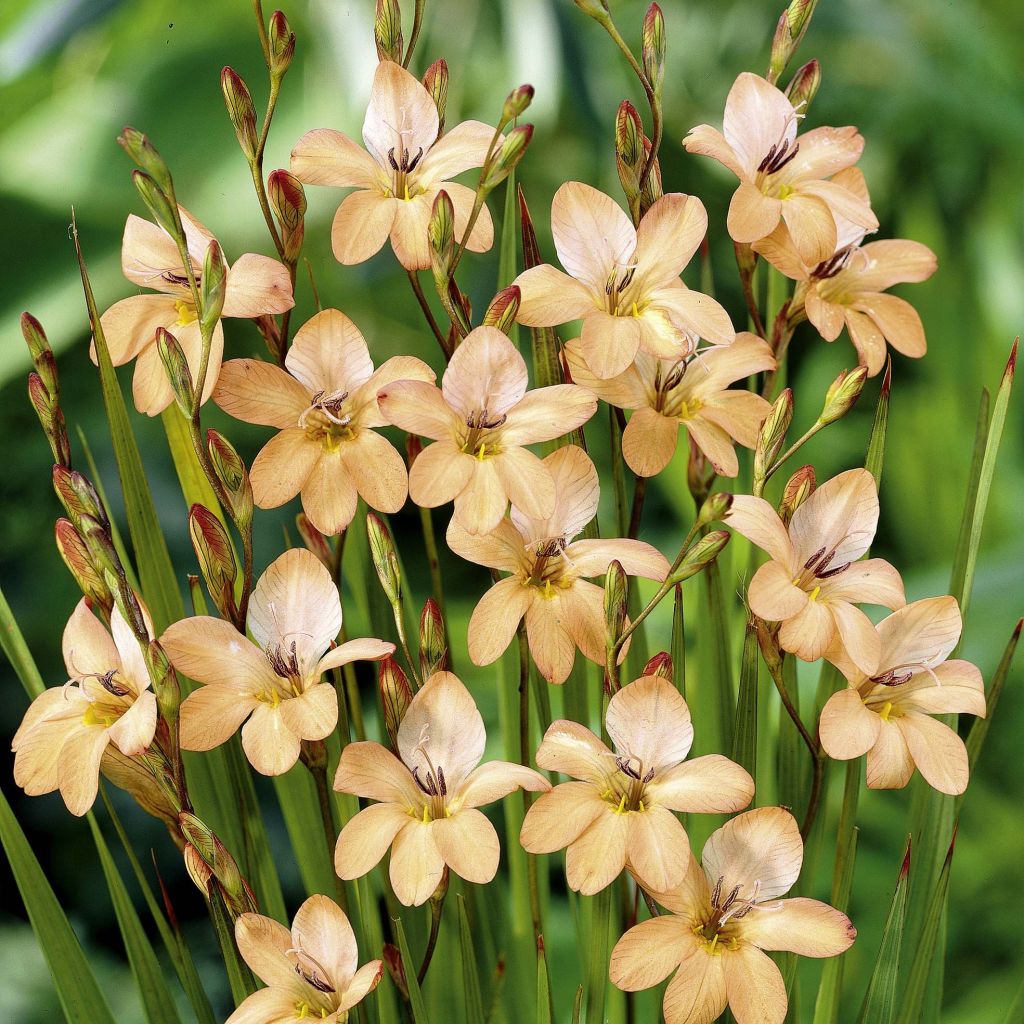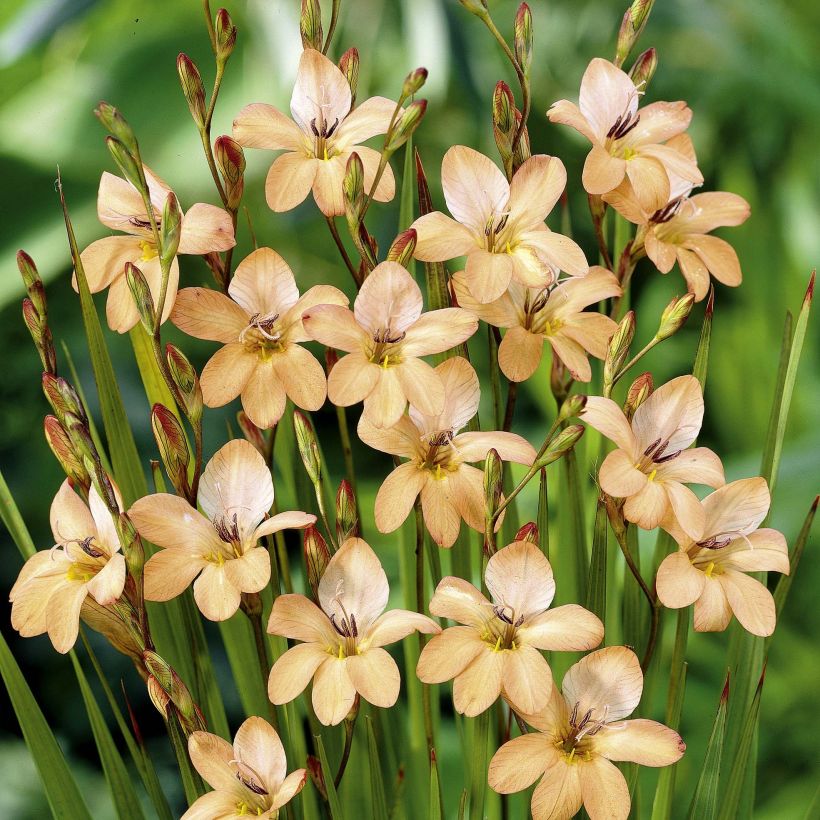

Tritonia laxifolia
Tritonia laxifolia
Tritonia laxifolia
Tritonia
This plant carries a 6 months recovery warranty
More information
We guarantee the quality of our plants for a full growing cycle, and will replace at our expense any plant that fails to recover under normal climatic and planting conditions.
From €5.90 for pickup delivery and €6.90 for home delivery
Express home delivery from €8.90.
Does this plant fit my garden?
Set up your Plantfit profile →
Description
Tritonia laxifolia (synonym Montbretia laxifolia) is a small South African bulbous plant, rare in cultivation, not very hardy, which is generally grown in pots in our climates. In summer, a clump of small narrow leaves emerges, with short flowering stems, each carrying about ten delicate small flowers in a chamois orange colour, carried on the same side of the stem. You will plant the bulbs in spring in a lovely pot, to be stored in a frost-free place during winter, in a cold greenhouse or a conservatory. In frost-free coastal gardens, plant them in small groups in a rockery or in a well-drained bed, remaining moist during the growth and flowering period, but dry for the rest of the year.
Tritonia laxifolia belongs to the Iridaceae family. This botanical species is native to a region ranging from the Eastern Cape in South Africa to the south of Tanzania. In nature, this small plant of grassy slopes has a winter vegetation (mild and humid winter) and blooms in late summer. It is a herbaceous perennial plant with a globose corm as its storage organ. The foliage forms a small clump of 4 to 6 linear leaves, shaped like swords, resembling those of gladioli. The flowering occurs in summer in our climates. The flowering stems, often branched, measure about 15-20cm (6-8in) in height. The small flowers have a long tube that widens into 6 rounded petals of orange colour, finely edged with red. The upper petal is larger, the 3 small lower petals are adorned with small horn-like yellow protrusions. The plant goes into dormancy for a while after flowering, preferably in a fairly dry soil.
Tritonia laxifolia, a lovely plant sought after by enthusiasts of South African bulbous plants, has certain requirements. Growing it in a pot allows easy control of the moisture in the growing medium, an important factor for success, and allows to keep the corms at a mild temperature in winter. Resembling a dwarf Crocosmia, this Tritonia will particularly blend well with warm-toned daylilies or Freesias.
Report an error about the product description
Tritonia laxifolia in pictures


Plant habit
Flowering
Foliage
Botanical data
Tritonia
laxifolia
Iridaceae
Tritonia
South Africa
Planting and care
Plant Tritonia corms at a depth of 8-10cm (3-4in), in a sunny location, in light and well-drained soil rich in compost. The plant should not lack water throughout the growth and flowering period. Afterward, the corms should be kept frost-free, in a fairly dry soil. In open ground (where it does not freeze), dig up the bulbs before the first frosts, and store them in a bit of turf, in a dry and cool place, during the winter. Divide the clumps every 3 years.
Planting period
Intended location
Care
This item has not been reviewed yet - be the first to leave a review about it.
Haven't found what you were looking for?
Hardiness is the lowest winter temperature a plant can endure without suffering serious damage or even dying. However, hardiness is affected by location (a sheltered area, such as a patio), protection (winter cover) and soil type (hardiness is improved by well-drained soil).

Photo Sharing Terms & Conditions
In order to encourage gardeners to interact and share their experiences, Promesse de fleurs offers various media enabling content to be uploaded onto its Site - in particular via the ‘Photo sharing’ module.
The User agrees to refrain from:
- Posting any content that is illegal, prejudicial, insulting, racist, inciteful to hatred, revisionist, contrary to public decency, that infringes on privacy or on the privacy rights of third parties, in particular the publicity rights of persons and goods, intellectual property rights, or the right to privacy.
- Submitting content on behalf of a third party;
- Impersonate the identity of a third party and/or publish any personal information about a third party;
In general, the User undertakes to refrain from any unethical behaviour.
All Content (in particular text, comments, files, images, photos, videos, creative works, etc.), which may be subject to property or intellectual property rights, image or other private rights, shall remain the property of the User, subject to the limited rights granted by the terms of the licence granted by Promesse de fleurs as stated below. Users are at liberty to publish or not to publish such Content on the Site, notably via the ‘Photo Sharing’ facility, and accept that this Content shall be made public and freely accessible, notably on the Internet.
Users further acknowledge, undertake to have ,and guarantee that they hold all necessary rights and permissions to publish such material on the Site, in particular with regard to the legislation in force pertaining to any privacy, property, intellectual property, image, or contractual rights, or rights of any other nature. By publishing such Content on the Site, Users acknowledge accepting full liability as publishers of the Content within the meaning of the law, and grant Promesse de fleurs, free of charge, an inclusive, worldwide licence for the said Content for the entire duration of its publication, including all reproduction, representation, up/downloading, displaying, performing, transmission, and storage rights.
Users also grant permission for their name to be linked to the Content and accept that this link may not always be made available.
By engaging in posting material, Users consent to their Content becoming automatically accessible on the Internet, in particular on other sites and/or blogs and/or web pages of the Promesse de fleurs site, including in particular social pages and the Promesse de fleurs catalogue.
Users may secure the removal of entrusted content free of charge by issuing a simple request via our contact form.
The flowering period indicated on our website applies to countries and regions located in USDA zone 8 (France, the United Kingdom, Ireland, the Netherlands, etc.)
It will vary according to where you live:
- In zones 9 to 10 (Italy, Spain, Greece, etc.), flowering will occur about 2 to 4 weeks earlier.
- In zones 6 to 7 (Germany, Poland, Slovenia, and lower mountainous regions), flowering will be delayed by 2 to 3 weeks.
- In zone 5 (Central Europe, Scandinavia), blooming will be delayed by 3 to 5 weeks.
In temperate climates, pruning of spring-flowering shrubs (forsythia, spireas, etc.) should be done just after flowering.
Pruning of summer-flowering shrubs (Indian Lilac, Perovskia, etc.) can be done in winter or spring.
In cold regions as well as with frost-sensitive plants, avoid pruning too early when severe frosts may still occur.
The planting period indicated on our website applies to countries and regions located in USDA zone 8 (France, United Kingdom, Ireland, Netherlands).
It will vary according to where you live:
- In Mediterranean zones (Marseille, Madrid, Milan, etc.), autumn and winter are the best planting periods.
- In continental zones (Strasbourg, Munich, Vienna, etc.), delay planting by 2 to 3 weeks in spring and bring it forward by 2 to 4 weeks in autumn.
- In mountainous regions (the Alps, Pyrenees, Carpathians, etc.), it is best to plant in late spring (May-June) or late summer (August-September).
The harvesting period indicated on our website applies to countries and regions in USDA zone 8 (France, England, Ireland, the Netherlands).
In colder areas (Scandinavia, Poland, Austria...) fruit and vegetable harvests are likely to be delayed by 3-4 weeks.
In warmer areas (Italy, Spain, Greece, etc.), harvesting will probably take place earlier, depending on weather conditions.
The sowing periods indicated on our website apply to countries and regions within USDA Zone 8 (France, UK, Ireland, Netherlands).
In colder areas (Scandinavia, Poland, Austria...), delay any outdoor sowing by 3-4 weeks, or sow under glass.
In warmer climes (Italy, Spain, Greece, etc.), bring outdoor sowing forward by a few weeks.



































